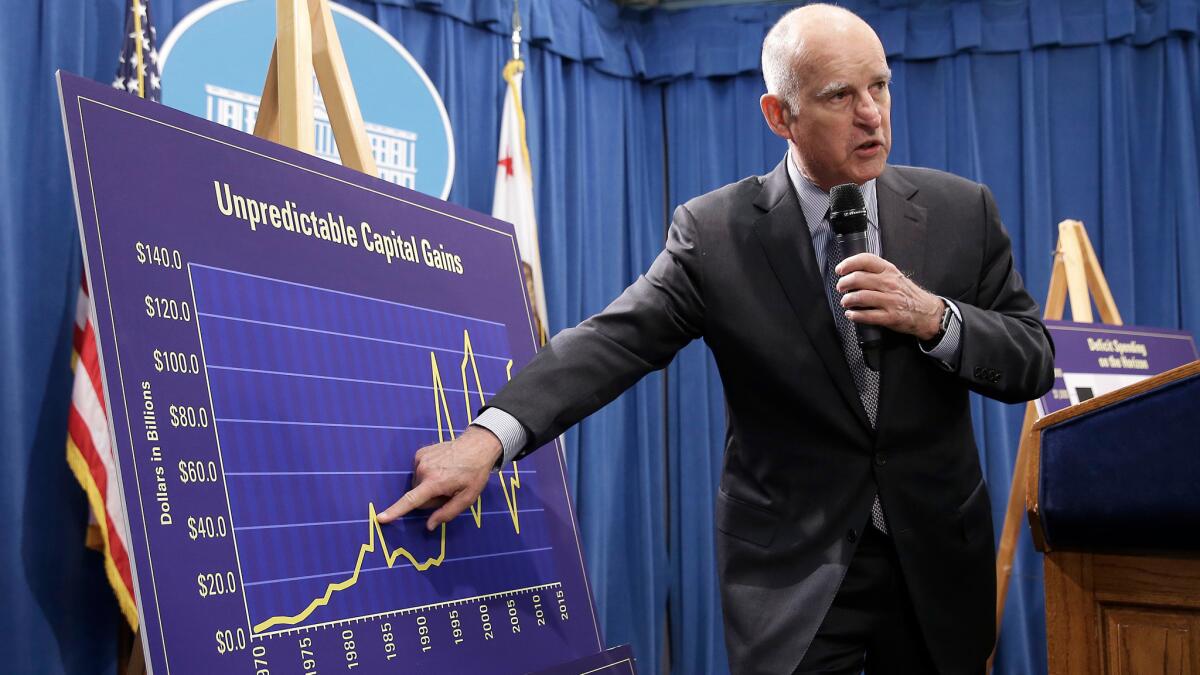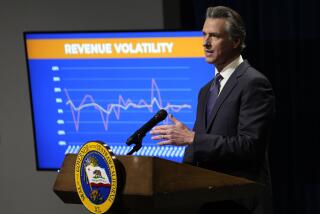Gov. Jerry Brown sends lawmakers revised California budget with less money to spend on new programs

- Share via
Reporting From Sacramento — Gov. Jerry Brown sent legislators a revised version of his state budget on Friday, insisting that lawmakers hold overall spending flat while endorsing a $2-billion bond to help the homeless.
“We have the money, and it’s a serious problem,” Brown said at a state Capitol news conference.
The support for a housing bond, which still would face sizable legal and political hurdles, was the most noticeable pronouncement in a $173.1-billion spending plan that otherwise holds the line on new programs and confirms a noticeable erosion in state revenues compared to estimates from January.
Overall, tax receipts are now expected to shrink by $1.9 billion. And Brown’s budget team continues to say that California could face as much as a $4-billion deficit by the summer of 2020.
“Right now, the surging tide of revenue is beginning to turn,” he said.
The budget revision boosts overall spending by $2.4 billion relative to Brown’s January proposal, a reflection of new healthcare costs covered by a tax on insurance plans enacted by lawmakers in January — one that does not depend on general taxpayer funds to administer.
Analysts said weakening tax revenues are the result of a tumultuous winter on Wall Street and the subsequent impact on the capital gains earned by some of California’s wealthiest taxpayers.
The state’s high-income earners provide the largest single share of tax revenues, and changes in the value of their stock portfolios have often meant steep peaks and valleys in available budget dollars.
That may help explain Brown’s endorsement of the bond measure to help tackle homelessness among the mentally ill. The borrowing plan would require a bipartisan vote in both houses of the Legislature, and would be paid off with money from an existing mental health tax on Californians who earn more than $1 million a year.
Nonetheless, Democrats praised the decision.
“Homelessness plagues communities across our state,” said Senate President Pro Tem Kevin de León (D-Los Angeles), one of the original authors of the plan. “To have the governor’s support provides a huge boost.”
In the months since his initial budget proposal, Brown has left some Democrats with the impression that he might look favorably on a number of new proposals, like a $1.3-billion proposal for more affordable housing and an $800-million boost in early child care and education programs. They were particularly encouraged by his comments in signing a law to boost California’s minimum wage last month, in which he spoke of “economic justice” for those in need.
Republicans also have proposed spending that would impact the bottom line, including expanded dental benefits in the Medi-Cal program and a package of new tax breaks.
But Brown urged legislators on Friday to hold the line and instead embrace his effort at boosting the state’s cash reserves to $8.5 billion, thus setting aside even more money than is required by law.
His revised budget offers only a few new ideas, all with relatively low price tags. Among them, the governor is proposing $10 million in new spending for California’s early earthquake-warning system and $30 million in additional dollars for help in the event of wildfires and to deal with the impacts of the ongoing drought.
The governor’s revised budget kicks off what likely will now be an intense month of negotiations between Brown and legislative leaders. By law, legislators must send a final spending plan with any revisions to the governor by June 15.
The state’s new fiscal year begins July 1.
Brown has spent most of the past few months warning of looming budget deficits and shortfalls that would fail to cover current spending commitments. And he has tried to square those gloomy projections with his rosier promises made to voters in 2012 that a temporary tax, Proposition 30, would provide the needed funds to help stabilize future budgets.
The ballot measure’s sales tax increase expires on Dec. 31, and its income tax increase on the most wealthy would expire at the end of 2018. A coalition of labor unions and healthcare groups is now poised to place an extension of the income tax hike on the Nov. 8 ballot. Those taxes, imposed on the state’s most wealthy taxpayers, otherwise would begin to expire in 2018.
While the governor declined to endorse the new tax initiative Friday, his budget advisors project that if voters pass the proposal, the state will maintain a slight surplus of tax revenue through the summer of 2020. If they don’t, the deficit could rise to as high as $4 billion.
Still, Brown downplayed the danger. “We can manage that deficit if we have to,” he told reporters Friday.
The revised budget reaffirms the relatively good news for public schools offered by the budget proposed in January — in all, a 52% increase in K-12 spending over the past five years. And it continues to urge lawmakers to take action on finding a long-term fix for California’s crumbling infrastructure, an issue that remains stalled in the Capitol.
The governor and his staff tried to inject some levity into the otherwise staid budget presentation by invoking the legendary Aesop’s fable of the ant and the grasshopper, the story that depicts the perils of not planning for the potential problems of the future.
“The notion is when you’re in the late summer, you should remember winter’s coming down the road,” Brown said, smiling.
Follow @johnmyers on Twitter, sign up for our daily Essential Politics newsletter and listen to the weekly California Politics Podcast
ALSO:
Democrats are hoping Gov. Jerry Brown loosens his grip on state spending
Everything you need to know about healthcare tax passed by the Legislature
UPDATES:
2:19 p.m.: This article has been updated throughout with additional context and new details.
This article was originally published at 1:50 p.m.
More to Read
Get the L.A. Times Politics newsletter
Deeply reported insights into legislation, politics and policy from Sacramento, Washington and beyond. In your inbox twice per week.
You may occasionally receive promotional content from the Los Angeles Times.











